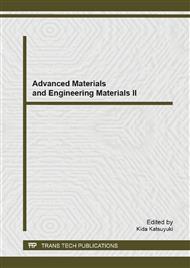p.7
p.11
p.17
p.21
p.25
p.30
p.34
p.38
p.42
Study on Synthesis of Cyclotriphosphazene Containing Aminopropylsilicone Functional Group as Flame Retardant
Abstract:
A novel non-halogen flame retardant APESP, cyclotriphosphazene containing six aminopropyltriethoxysilicone functional groups N3P3[NH(CH2)3Si(OCH2CH3)3]6, was synthesized by menas of SN2 nucleophilic substitution reaction, using hexachlorocyclotriphosphazene(HCCP) and 3-aminopropyltriethoxy-silane (KH550) as material. Firstly the industrial grade HCCP was purified through recrystallization and sublimation. Then the reaction process was investigated to prompt the yield, and the optimum reaction conditions were as follows: triethylamine as acid-binding agent, tetrahydrofuran as solvent, HCCP/KH550/triethylamine molar ratio 1:7.2:7.2, dripping time: 1 hour, temperature: 67°C and reaction time: 20h. Maximum APESP yield reached 94.3%. The chemical structure and purity was characterized by element analysis, Fourier-transformed infrared spectroscopy (FTIR), mass spectrum, gel permeation chromatography (GPC) and nuclear magnetic resonance (NMR) analysis. The results showed that the structure of synthesized product is consistent with the theoretical structure, in which the chlorine atoms were completely substituted. The charge distribution calculation of HCCP and KH550 confirmed the reaction mechanism.
Info:
Periodical:
Pages:
25-29
Citation:
Online since:
April 2013
Authors:
Price:
Сopyright:
© 2013 Trans Tech Publications Ltd. All Rights Reserved
Share:
Citation:


